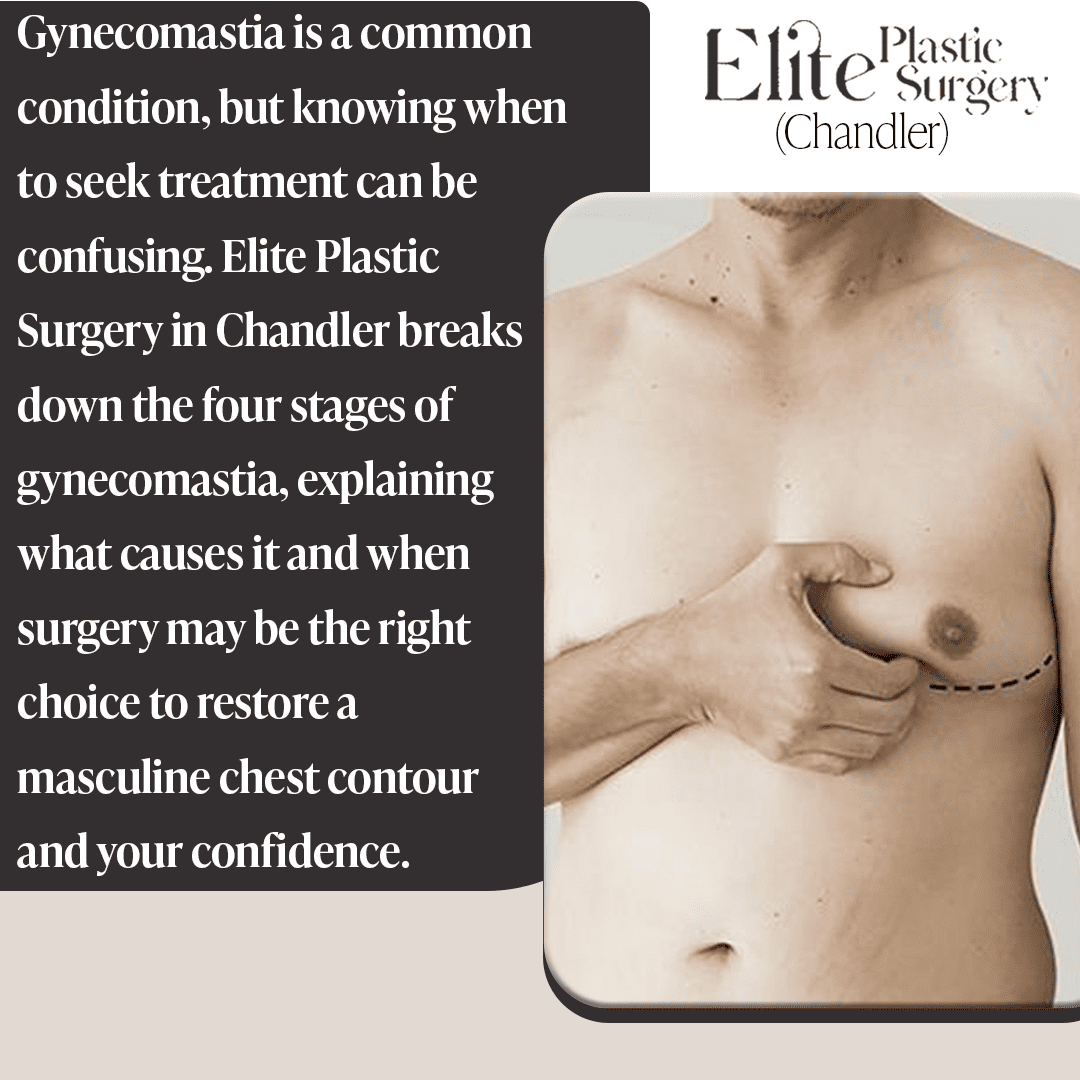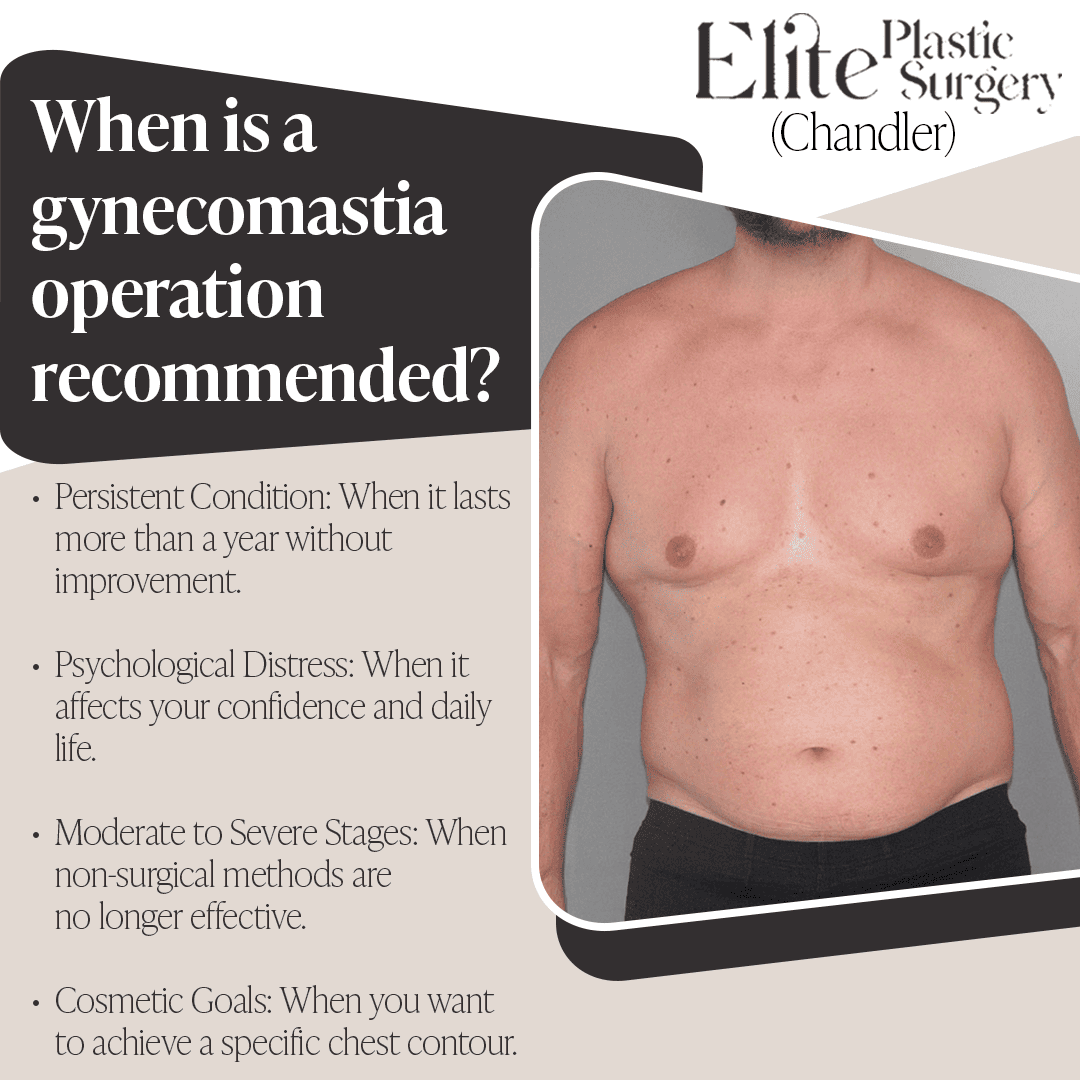Elite Plastic Surgery Outlines When Gynecomastia Requires Surgery Based on Stage
Chandler, United States - November 3, 2025 / Elite Plastic Surgery (Chandler) /
Chandler, AZ – Gynecomastia is a common condition in men, and knowing its stages can help guide effective treatment. Elite Plastic Surgery Chandler, AZ, a leading plastic surgery practice, explains the four stages of gynecomastia, how the condition progresses, what causes gynecomastia, and when a gynecomastia operation should be considered. This information aims to help men make informed decisions about gynecomastia treatment and restore confidence in their appearance.
Understanding Gynecomastia and What Causes It
Gynecomastia is the enlargement of male breast tissue due to a combination of hormonal imbalance (often elevated estrogen relative to testosterone), side effects of certain medications, weight gain, aging, or health conditions such as liver, thyroid, or kidney disease.
True gynecomastia is distinguished from pseudogynecomastia, which is excess fat without glandular breast tissue. Knowing what causes gynecomastia is essential because intervening with lifestyle change, adjusting medication, or seeking surgery depends on the cause, duration, and severity.
The Four Stages (Grades) of Gynecomastia
Medical classification divides gynecomastia into four grades, or stages. Each stage reflects the severity of tissue growth, skin excess, and how visible or bothersome the condition is. Treatment options and timing depend greatly on the stage.
Stage / Grade | Characteristics | When Surgery or Treatment Should Be Considered |
Grade I | Mild enlargement around the nipple (areola), little to no excess skin, skin elasticity still good. | Non‑surgical treatments such as lifestyle change, weight loss, possibly hormone assessment. If persistent beyond ~6‑12 months, or highly bothersome, liposuction or minor excision may be effective. |
Grade II | Moderate enlargement extending beyond areola into broader chest area; skin still retains good elasticity though slight looseness may appear. | Combination of liposuction + tissue excision often recommended. Psychological impact increases – patients often consider operation to restore contour. |
Grade III | More pronounced breast tissue, visible breast‑like contour, moderate skin stretch, possible nipple displacement or enlargement. | Surgical operation becomes more necessary: removal of glandular tissue, excision of excess skin, possible repositioning of nipple‐areola complex. |
Grade IV | Severe enlargement, large excess tissue and skin, pronounced female‑like breast appearance, possibly sagging, discomfort with clothing and activities. | Complex gynecomastia operation needed: excision, skin removal, nipple repositioning. Staged procedures may be required for optimal results. |
Factors That Influence Progression
Not all gynecomastia cases follow the same timeline. Several factors influence how fast or how severely the condition progresses through stages:
Hormonal Changes: Puberty, aging, or endocrine disorders can alter hormone balance.
Weight Gain / Obesity: Fat tissue can increase estrogenic activity, worsening breast enlargement and reducing skin recoil.
Medications and Substance Use: Some drugs, steroids, or alcohol may contribute.
Duration of the Condition: The longer gynecomastia persists, especially beyond one year, the more likely fibrosis (hard tissue), skin stretch, and permanent changes occur.
When to Consider a Gynecomastia Operation (Surgery)
Elite Plastic Surgery recommends considering a gynecomastia operation when:
The gynecomastia has persisted for a significant period (usually more than 12 months) without improvement from non‑surgical methods.
The patient is experiencing psychological distress, limitations in daily life (e.g. avoiding certain clothing or activities), or physical discomfort.
The stage is moderate to severe (Grade II‑IV), where glandular tissue, fat, and skin excess are beyond what lifestyle changes or medical therapies can effectively manage.
Cosmetic goals demand contour improvement that only surgery (liposuction, tissue excision, skin removal, nipple repositioning) can deliver.
Elite Plastic Surgery’s Approach to Gynecomastia Treatment
Elite Plastic Surgery provides board‑certified plastic surgeons experienced in all stages of gynecomastia. Treatment plans begin with a thorough medical history, identification of causes, physical examination to determine tissue type and skin elasticity, and assessment of patient goals. Based on the stage, the operation may involve:
Liposuction for fat removal in early to moderate cases.
Direct excision of glandular tissue.
Combined approaches (liposuction + excision).
Skin removal and contour tightening in advanced (Grade III‑IV) stages.
Recovery and results vary by stage and complexity, but Elite Plastic Surgery emphasizes patient education, realistic expectations, and compassionate support throughout the process.
Taking Action Based on Your Gynecomastia Stage
Understanding the stages of gynecomastia is the first step toward reclaiming your confidence. If you're experiencing symptoms, don't wait. Contact Elite Plastic Surgery at (480) 291-6895 or contact@epsaz.com to schedule your personalized evaluation and discover the most effective treatment plan for your unique needs. This leading plastic surgery clinic’s board‑certified surgeons specialize in gynecomastia treatment in Chandler, among other cosmetic and reconstructive procedures. They emphasize patient safety, natural‑looking results, and individualized treatment plans.

Contact Information:
Elite Plastic Surgery (Chandler)
1120 S Dobson Rd Suite 110
Chandler, AZ 85286
United States
PR Dept
(480) 291-6895
https://eliteplasticsurgeryaz.com/
Original Source: https://www.eliteplasticsurgeryaz.com/blog/gynecomastia-stages-how-the-condition-progresses-and-when-to-consider-surgery/



